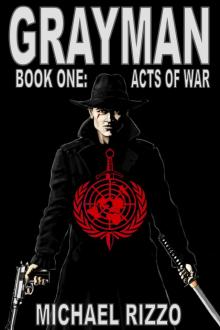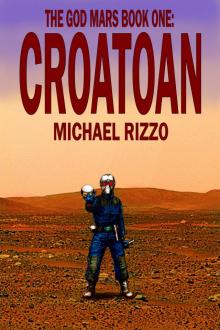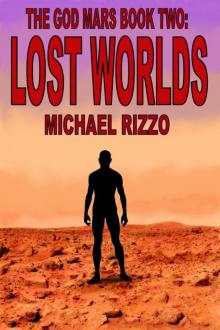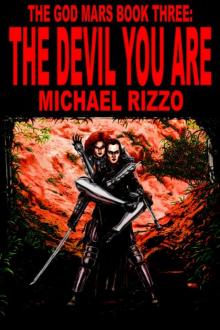- Home
- Michael Rizzo
The God Mars Book Two: Lost Worlds Page 7
The God Mars Book Two: Lost Worlds Read online
Page 7
“Holy shit…” is the best Matthew can manage.
“You could live there,” Tru sighs.
It only gets greener as it goes. Within another thirty miles, our hardy Graingrass is climbing up out of the crevices and spreading like thick-bladed prairie grass across the valley floor. In places, it reaches up to the sky like grove bamboo, four or five meters tall, swaying in the winds.
The soil and rock has turned a deeper terra-cotta color, and its textures look like water has indeed fallen recently: there is the familiar cracking that happens to drying mud, and signs of drainage where the dust and sand is now a swirling, veined clay.
“You think it actually rains here?” Acaveda asks, dumbstruck.
“Looks very much like where I grew up in the American Southwest,” I tell her.
“Or Australia,” Tru offers.
“Doesn’t look like Mars,” Jane comments as he flies on.
I feel numb. This completely different world was less than a hundred miles from us all this time, and my caution kept us from exploring it.
“Take your time,” I tell the pilots, trying to sound like I’m still confident in my decision making. “Get good imaging. This is all getting sent back to Earth.”
The closer they get to Tranquility, the more it looks like the high-plateau deserts I visited in my youth: Tundra dotted with shrubbery and grass in the open flatlands, but with gardens and groves clinging to the canyon walls and ravines where water is likely to accumulate when the desert gets rain.
“You’d think the Power Rangers would have shown this place off first chance they got,” Matthew criticizes, considering how much the ETE have played us their dreams for continuing to terraform Mars as proof of their benevolent designs.
“It’d go far in making Earth forget what they’re afraid of,” Lisa considers with less overt suspicion, but that only proves Matthew’s point: Why didn’t the ETE show us this immediately?
I try to remember what the ETE did tell us. I mostly remember idle comments about ecosystems, green-frosted orbital images, computer models. No actual images or details about this region except for the vague warnings about hostile locals. I got far better intel from Abbas, who only had the second-hand tales of food traders who probably exaggerated to discourage competition.
“It would sell me,” Tru agrees, the heavy concession in her tone reminding me that she and her Ecos bled dearly to try to stop the very research that made this possible. The ETE should be ecstatic about what’s happening here.
“So why the lack of advertising?” Matthew pushes his point. “What’s wrong with this pretty scene?”
“It doesn’t look that scary,” Kastl idly agrees.
“It’s beautiful, sirs,” Thomas comes on, her voice echoing inside her helmet. “You really need to see this up close.”
I remind her to look for signs of activity, maybe even the trails used for the Nomad food routes.
“Stay focused, Lieutenant.”
The colony ruin comes into view in another few minutes.
Tranquility’s three big domes were built “stacked” up a steep ravine cut into the south rim of Coprates—the Datum-high ridge that separates Coprates from the parallel Catena. The divide is ribbed with such cuts. The colony scientists built into one of the larger and wider ones looking to study erosion (hoping it was due to ancient water and not just crust fracturing) and exploit the exposed geologic history of the valley.
We can barely see the jagged, twisted lines of the lower dome. It’s surrounded by green, overgrown with it, and large sections of the dome are shattered. The other two domes are completely buried under talus as the ridge apparently slid down on them, creating a new slope now covered by a veritable forest, all in the shadow of the newly-exposed cliff face that towers over the colony ruin. The landing pads of the airfield just to the east are still visible in the growth, partially buried, but the dock facilities look smashed.
The scene immediately reminds me of pictures of Southeast Asian temple ruins taken over by the jungle, only it looks like this jungle may have blossomed out of the burst dome like Tranquility was its seed.
“I’m no botanist,” Tru offers, “but it does look like a lot of the wild growth we’ve seen so far may have started here.”
“Tranquility had some impressive gardens,” Lisa remembers, “multi-story hydroponic farms.”
“But did it have survivors?” Matthew refocuses.
“If the domes were all compromised, anyone who survived the slide would have been hurting for air and heat,” Doc Ryder assesses. “Their seedlings could have gone into stasis, then germinated again years later when it got more temperate, but the colonists may have needed to relocate.”
“But I’d come back home, especially if it was like this,” Tru counters. “Or somebody’d be bound to move in.”
“Thomas to Ops,” she cuts in. “Look at this…”
The feed locks on a spot just east and downslope of the pads. There’s nothing there but rock and green, but closer scans show scars of old construction. Thomas overlays the original colony blueprint.
“Fuel dump is gone,” Anton confirms. “Not buried. Moved.”
“Scavengers?” Acaveda wonders.
“Or the colonists trying to keep it from scavengers,” Tru considers.
“What did Abbas say about the site?” Lisa asks me to refresh them.
“Something about wild people being hunted by another group for sport,” I recall. “It’s where his revolver supposedly came from. Nice piece. Lots of custom work on it. The kind of weapon you use for precision shooting—sport, not combat. I tried checking to see if guns like that came in on any of their cargo drops, but MAI’s files on colony manifests are long since dumped.”
“But it’s easily possible someone who still has guns would use them on those who don’t,” Matthew voices his usual opinion of human nature.
“A food source like this would stir powerful competition,” Lisa allows.
“You think both groups may live in there somehow?” Thomas asks.
“Or close by,” Tru extends.
“Busted and buried hasn’t been what it looks like,” Matthew reminds us of the Shinkyo and PK sites. “If it ain’t stripped, it’s occupied. Either one faction holds the place, or it’s a DMZ. Site looks like it’s got a lot to fight over.”
“Other than the missing tanks, there’s no sign of any activity—past or present—within what we’ve seen around the dome,” Thomas assesses. “If the Nomads have been trading or raiding here, they’re careful not to leave trails.”
“Circle and land out of sight-line,” I tell Acaveda and Jane. “The Nomads are at least as afraid of this place as they are of the PK colonies, and we had a time just getting within a klick of them. Follow defensive protocols. No unnecessary risks.”
“Isn’t this where the Lancer potentially became a ghost-ship?” Thomas recalls.
“That’s the rumor,” I confirm. “Stay sharp—they’ve probably seen you coming. Watch for snipers and ambushes. And everybody out if it comes to shooting.”
The ships find a spot to touch down just to the west, in the foothills of the Divide, putting one of the branching ridges between us and the colony without giving up too much high ground.
Thomas takes her time. Sets up a sniper team across the ridgeline overlooking her planned approach, which will also give us a clear Link feed to watch over them. Then she hikes in with one squad, leaving Jones in charge of the LZ (and her backup).
The squad does its best to hug the natural cover. It takes them half an hour to make the crossing at a pace that won’t create rockslides. Then her point man picks out what looks like an actual water-formed arroyo that seems to flow from the shattered lower dome. It’s lined with healthy plant life—enough to make our greenhouse seem sparse—but it’s too wide and shallow for real cover. It seems to form the most natural path to the dome. They creep up on it enough to check the soil in the broad “bed”.
“That
’s mud,” Tru confirms. “Or at least it was recently. Which means there’s flowing water here.”
Thomas orders her point man—Specialist Jenovic—to take a quick sample and then get back out of sight. Then they take the slow crawl over the rocks, following the ridge slope toward the dome.
Heat and motion sensors show nothing but greenery rustling in the wind. The lower dome is almost the size of a football stadium. Most of the facetted roof is broken in, but the overgrowth hides the structures—the lab, utility and hydroponic modules—that plans show should be filling the dome, surrounded by the terraced experimental gardens. The exposed dome was devoted to research agriculture, developing hybrids ideally suited to green Mars. What we’ve seen is a testament to their success (possibly posthumously).
Of the buried (or crushed) domes, one was devoted to terraced hydroponics, food processing and colony support systems, and the other to colony living and management facilities. There was also a small-core reactor, supplemented by solar arrays.
Now that we have a perspective from the ground, I have MAI project a 3-D model of the original colony structures over the wrecked dome and slide slopes. The other two domes could well be concealed whole and intact under the greened-over slide mass.
I watch multiple Link feeds as Thomas divides her squad into fire teams: one to cover while the other moves in to get a look inside the exposed dome. The fact that they’ve managed (or been allowed) to approach this close without resistance is not a comfort.
There’s an old cargo bay hatch at ground level, opening into the arroyo. Its doors are long gone. Vines of Graingrass and Rustbean snake out of it and spread up over the dome to join hundreds more growing out of the jagged breaches and out across the ravine. The ground still shows no sign of recent tracks.
“Somebody cut these hatch doors away a long time ago,” Thomas examines. “Scavengers?”
“I think if you were trying to defend the site from competitors, you’d want those heavy doors,” Lisa assumes.
“Unless you want your enemies walking in,” Matthew says it before I do.
Taking that to heart, Thomas lets MAI sweep through the open hatchway without putting anyone in a possible firing line. The hatchway opens into an equally door-less cargo-sized airlock, that in turn opens directly into the dome. It reminds me of an old castle gate.
“Still no sign of activity,” she reads MAI’s assessment. “Going in…”
“We don’t have you covered once you’re through that door,” Sergeant Masters—who’s leading the sniper team—cautions her.
“Understood, Sergeant,” Thomas tells him, not sounding terribly confident. Still, she does her job.
The H-A team leapfrogs smoothly through the open hatchway, covering each other and as many angles of attack as they can anticipate. Their boots crunch on a combination of undergrowth and damp mud that’s flooded the original dome floor. The interior is a jungle—only a few of the edges of the original terrace-like garden decks can be made out.
“Does this look like blood?” I hear Spec-4 Regev ask as his feed shows us one of the internal support columns. It’s twisted with vines and its original white enamel paint is chipped and battered, but there are smears of dark reddish brown too dark to be Martian mud. Pulling away some of the overgrowth, we can see these aren’t random markings—they look like the finger-painted letters of a child.
I read what might be names: “MAK” “2GUN” “FERA” “SPYK” “AKS” “DART”
Next to each name are rough tally marks, like the scorecard of a child’s game.
“It looks like blood,” Thomas confirms softly.
“Holy…”
Jenovic—still on point—has stopped dead in his tracks, his hand up in the fist-sign for “hold.” His own feed points down at his boots, crunching on something under the thick net of vines. He kicks up something thin and slightly curved, about eight inches long, that looks like a piece of brown-stained ivory.
“Rib bone,” Doc Ryder tells them over the Link, taking a breath as Jenovic pans up. What had looked from a distance like a vine-covered mound starts to focus into a hill of human bones, at least twelve feet wide and taller than Jenovic. He has to back up to get a shot of the top of it, which is crowned with roughly-polished human skulls.
“Lieutenant?” Jenovic asks for advice, trying to keep from sounding as unsettled as he must be. Thomas gestures for everyone to get low, cover their perimeter.
I click up a separate channel and signal Abbas’ Link. It takes him a few seconds to answer. His face on my screen shows he’s in his shelter. I see his women getting a meal ready over his shoulder.
“Ah, my friend…” he begins with his usual warmth.
“Rather urgent question,” I press him. “The food route caravans from Coprates: What do you give them in exchange?”
He looks a bit bewildered, thinks his answer over for a moment, then tells me what he had before: “Survival gear. Weapons. Food and medical supplies from the sky drops when we can.”
“But the sky drops have gotten less and less,” I remind him. “Has that changed what you trade with?”
“It did not make much matter, friend Ram,” he considers. “Once they have refilled their air and water reserves, the traders have always been most interested in acquiring weapons and armor—as much as we can give them.”
“What kind of weapons?” I press again.
“What we blacksmith,” he tells me with a shrug. “Knives, crossbows, axes, throwers…”
“Given the quantities you’re trading them, do you think the weapons are for their own use, or are they more likely trading them in turn?”
“They don’t return with much of what they took,” Abbas calculates thoughtfully. “And they’ve taken enough these last few years alone to arm at least a small tribe.”
“Do they ask for any guns?” I probe.
“Guns have been far too precious,” Abbas muses. “A man would rather give up his right arm than his gun if he has one.”
“What about ammunition?”
“They always ask if we have any pistol rounds. Not rifle or PDW shells. And only nine millimeter cased.”
“Your revolver is a .357 with a 9mm conversion cylinder…” It isn’t a question. He’s let me have a good look at his gun on more than one occasion. He nods anyway.
“Why do you ask?”
“I think we’ve just done something stupid.”
I click him off without saying goodbye and get back on with Thomas.
“Back out of there,” I order. “Carefully.”
She signals her troops, and they start to rise.
“Hey…” Jenovic says.
Up on top of the hill stands a human-looking figure: very thin, wearing an assortment of dirty and worn colony gear, except for his jacket which I recognize as the black and gray light-armor uniform of the old mercenary colony corporate security. He also wears a floppy old outback hat and filtered goggles. His minimal breather mask is down around his neck, showing his weathered and boney features, his chopped rusty scruff of a beard.
He got up there—up on top of a mound of bones—without making a sound. He stands looking down at our team with his arms hanging at his sides, hands open and hovering over the grips of twin pistols—revolvers—slung on each thigh like a gunslinger.
A half-dozen ICWs lock on him. He stands like a statue.
“We don’t mean you any harm,” Thomas tries to reassure. “We come to help you.”
“Multiple contacts!” Regev announces frantically. MAI is lighting up the greenery with motion blips. The jungle inside the dome looks like it’s swarming with fireflies. The greenery rustles as if a storm has hit it.
“We don’t mean you any harm!” Thomas repeats, backing away. “We don’t want a fight!”
I think I see the gunslinger smile.
“Draw…” he says coolly.
I don’t really see him move. He pulls both guns and fires in a fraction of a second. Jenovic and Park have
their ICWs shatter in their grip, and Park screams with the fingers of his left hand shattered into meat. Regev and Wasserman open up reflexively, but the gunslinger does a graceful back flip and disappears from sight. Then Regev and Wasserman cry out.
“Fuck…!!”
On the feed I see homemade-looking knives sticking through the elbow joints of their armor. Then Regev jerks back and his feed goes skyward. Thomas’ view shows me another knife buried in the gap between his shoulder armor and chest plate. I see him convulse on the vine-carpeted ground, his gloves clawing to get the knife out.
“GO! GO!” Thomas is shouting. Wasserman is trying to spray into the green with his surviving arm. Something big slams into him and he goes down flailing, rolling in the green with whatever has a hold of him.
Suddenly everything we can see is a chaos of leaping lunging creatures. It takes me several seconds to realize they are people: Wild, dirty, dressed in rags, swinging clubs and axes and spears. But they jump and fly through the air like monkeys. I get a shot of the one wrestling Wasserman: a tiny thing, mop of red dreadlocks with primitive beads woven in, bits of scrap-built armor. When her round cherub-like face flashes at the camera with a snarl, I can tell she’s a girl, big blue eyes and freckles, probably a teenager. She gets Wasserman on his back and jabs him savagely in the neck with an arm sheathed in metal, twin blades welded to protrude from her fist. Thomas tries to shoot her off of him, but the wild child leaps away. The way she moves reminds me of Sakina, only much more brutal and simian.
There are dozens like her leaping and lunging and stabbing and swinging and throwing things at our team. We get off a few shots, but hit nothing. They seem to coordinate their jumping so that they constantly cross each other, making it too visually confusing to track a target. It strikes me that they have specifically practiced this tactic because they’re used to someone shooting at them.
Thomas manages to grab hold of Jenovic and shoves him past her back toward the exit. Then she fires a spread into the leaping, jumping storm of bodies, giving Chen cover to fall back. Park is trying to follow, but I can see the shaft of a spear sticking out of his lower back just below the edge of his torso armor, and he begins to stagger and drag. Chen grabs hold of him to pull him on, and Park manages to tear a grenade free of his belt with his intact hand and toss it behind him. It bangs and smokes, pouring out a cloud of thick red fog. Thomas throws another one to add to it. It seems to drive the enemy back, but I doubt it will hold them.

 Grayman Book One: Acts of War
Grayman Book One: Acts of War The God Mars Book One: CROATOAN
The God Mars Book One: CROATOAN The God Mars Book Six: Valhalla I Am Coming
The God Mars Book Six: Valhalla I Am Coming The God Mars Book Five: Onryo
The God Mars Book Five: Onryo The God Mars Book Four: Live Blades
The God Mars Book Four: Live Blades The God Mars Book Two: Lost Worlds
The God Mars Book Two: Lost Worlds The God Mars Book Three: The Devil You Are
The God Mars Book Three: The Devil You Are